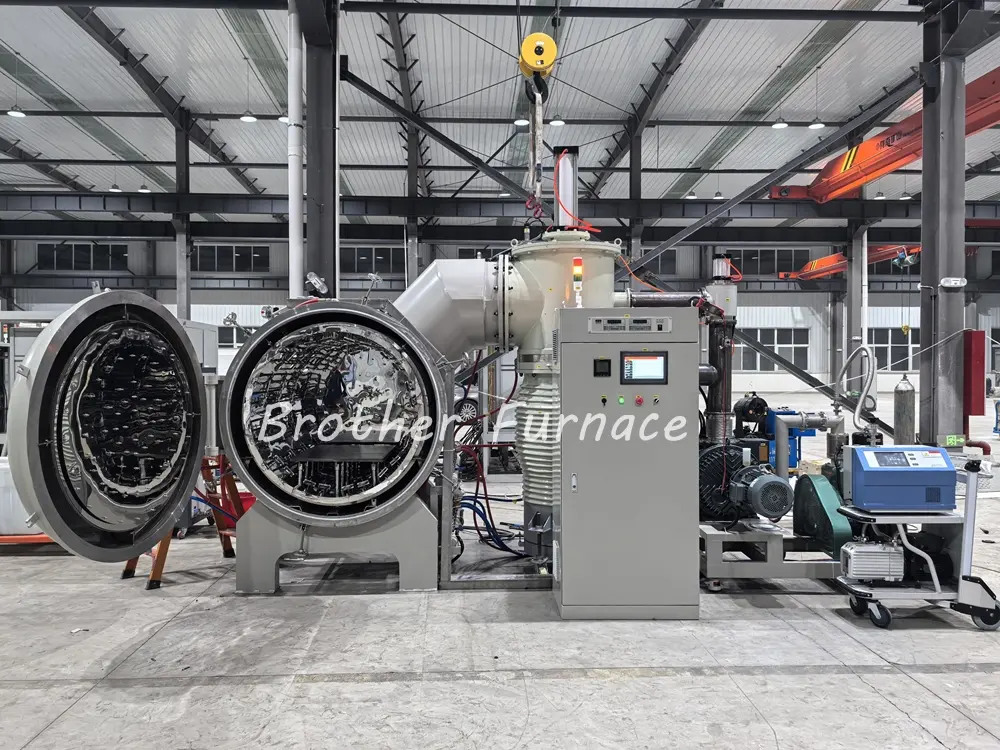The vacuum annealing furnace is a high-temperature heat treatment equipment designed for annealing processes in a vacuum environment. Here’s a comprehensive overview of vacuum Annealing furnaces:
What is Vacuum Annealing?
Vacuum annealing is a heat treatment process performed in a vacuum environment where materials are heated to specific temperatures and then cooled under controlled conditions. This process helps improve material properties by reducing internal stresses, increasing ductility, and enhancing overall material characteristics.
How Does the Vacuum Annealing Furnace Work?
The vacuum annealing furnace operates through a systematic process involving multiple stages:
1. Loading Stage
Materials are placed in the furnace chamber. The door is sealed with vacuum-tight gaskets
2. Vacuum Creation
A mechanical pump creates a rough vacuum, and a Diffusion/molecular pump achieves a high vacuum. (The Highest vacuum we can do is 7×10-4 Pa.)
3. Heating Process
Gradual temperature increase, controlled heating rate, and temperature uniformity maintained.
4. Holding Stage
Material held at target temperature. Specific duration based on material properties.
Microstructural changes occur, and Internal stresses relieved.
5. Cooling Phase
Natural cooling.
Forced gas cooling. (if needed)
Structure of Vacuum Annealing Furnace
- Vacuum Furnace Chamber: Ceramic fiber, molybdenum, or graphite, designed to withstand high temperatures and vacuum conditions.
- Heating System: Electric resistance heating elements including heating wires, SiC heating elements, and Mosi2 heating elements. Molybdenum or graphite heating elements.
- Vacuum System: Mechanical pump, Diffusion pump, Molecular pump.
- Control System:Temperature control: PID or PLC control.
Process automation: Programmable cycles, data logging, data export.
Pressure monitoring.(if needed) - Cooling System:Water cooling jacket.
Gas cooling system. (if needed)

Advantages of Vacuum Annealing Furnace
- Superior Surface Quality: No oxidation, Bright surface finish, Minimal decarburization.
- Better Process Control: Precise temperature control, Uniform heating, and Controlled cooling rates.
- Environmental Benefits: Clean process, No atmospheric pollution, Energy efficiency.
- Enhanced Material Properties: Improved mechanical properties, Better microstructure, Reduced internal stress.
Material Applications
Metals:
- Steel and alloy steel
- Stainless steel
- Copper and copper alloys
- Titanium and titanium alloys
Electronic Components:
- Semiconductor materials
- Electronic packaging
- Circuit boards
Special Materials:
- Rare earth materials
- Precious metals
- Advanced ceramics
Vacuum Annealing Furnace FAQ
Q: What is the typical processing time for vacuum annealing?
A: Processing time varies depending on material thickness and properties, typically ranging from 2-24 hours including heating and cooling cycles.
Q: What temperature ranges can be achieved?
A: Most vacuum annealing furnaces operate between 150°C to 1600°C, depending on the furnace design and heating elements.
Q: How does the vacuum level affect the process?
A: Higher vacuum levels provide better surface quality and prevent oxidation. The specific vacuum level depends on material requirements.
Q: What is the maximum batch size possible?
A: Batch sizes vary by furnace design, ranging from small laboratory units to large industrial furnaces. Our furnace size can be customized as per your needs.
Q: How energy efficient is vacuum annealing compared to traditional methods?
A: Vacuum annealing typically requires 20-30% less energy compared to atmospheric furnaces due to better heat transfer efficiency and reduced heat losses.
Q: What maintenance is required?
A: Regular maintenance includes:
- Vacuum pump service
- Heating element inspection
- Seal and gasket checks
- Cooling system maintenance
- Control system calibration
Q: What are the safety considerations?
A: Key safety aspects include:
- Proper vacuum release procedures
- Temperature monitoring
- Cooling water flow monitoring
- Emergency shutdown systems
- Regular safety inspections
In summary, the vacuum annealing furnace represents a crucial technology in modern manufacturing, particularly in industries requiring high-precision heat treatment and superior material quality.
See the details of our Vacuum Annealing Furnace…
If you Need a Quote or have any questions, please do not hesitate to Contact Us.
Follow us on Facebook